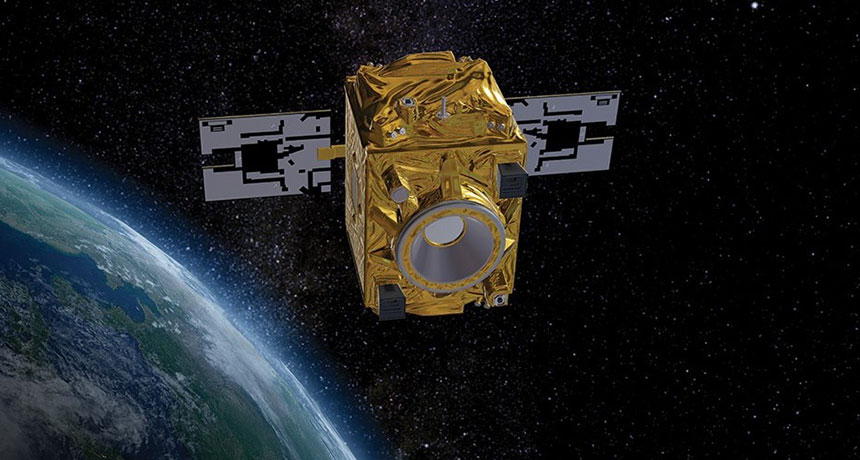Major gravity experiment recreated aboard a satellite
Super-precise data seem to confirm that Einstein got it right

Scientists compared how two objects fell within a satellite in orbit 710 kilometers above Earth (as depicted in this illustration).
(C) CNES/VIRTUAL-IT 2017
Galileo’s most famous experiment has taken a trip to outer space. The result shows Einstein was right — again. The testing confirms a major part Einstein’s theory of gravity. What’s more, it was about 10 times more precise than earlier such tests.
According to science lore, Galileo dropped two balls from the Leaning Tower of Pisa. In fact, it seems unlikely that Galileo actually carried out this experiment. But he supposedly was trying to show that those balls would fall with the same acceleration. Their change in speed due to gravity would be the same, no matter what they were made from or how much they weighed.
Scientists have now performed a similar experiment in a satellite. They dropped two hollow cylinders and measured them for more than 120 orbits. The cylinders were in free fall for about eight days’ worth of time.
This experiment was designed to test what’s known as the equivalence principle. It’s a foundation of Einstein’s gravity theory, the general theory of relativity. The equivalence principle states that two different ways of defining an object’s mass are actually the same.
Now stick with us here, because this can get a bit complicated. Mass is a way of quantifying how much “stuff” an object is made up of. One way to define mass is by how easily an object moves when pushed. That’s the kind of mass called “inertial mass.” An object with more inertial mass requires a more forceful push to increase its speed by a certain amount. A second way to define mass is by how strong a gravitational pull an object feels. That’s known as “gravitational mass.”
Einstein’s equivalence principle holds that this inertial mass is equal to the gravitational mass. And if that’s true, then two different objects should fall at the same rate (at least when they’re in a vacuum, where air resistance is eliminated). In a perfect vacuum, for instance, a feather will accelerate just as much as will a ball of iron.
In the satellite experiment, known as MICROSCOPE, the two cylinders’ accelerations did match — at least to within two-trillionths of one percent! The satellite, by the way, is still collecting additional data.
The result is “fantastic,” says physicist Stephan Schlamminger. He works at OTH Regensburg in Germany and was not involved with the research. “It’s just great to have a more precise measurement of the equivalence principle,” he says. Why? “Because it’s one of the most fundamental tenets of gravity.”
Researchers behind the new experiment described their findings December 4 in Physical Review Letters.
What the experiment did
The tests used one hollow cylinder made from a platinum alloy. It was centered inside a larger hollow cylinder. This one was made from a titanium alloy. General relativity predicts that despite their different masses and their being made of different materials, both cylinders should fall at the same rate.
Any violation of the equivalence principle, however, would allow one to fall slightly faster than the other.
Because the satellite they were on was orbiting Earth, the two objects were allowed to go into “free fall.” Equipment on the satellite then used electrical forces to keep the two cylinders aligned. If the equivalence principle did not hold up, those electrical forces would have to change over time to keep the cylinders in line. But they didn’t.
“If we see any difference in the acceleration [of the two objects] it would be a signature of violation” of the equivalence principle, says Manuel Rodrigues. In fact, he reports, they saw no hint of such a variation. Rodrigues is a MICROSCOPE researcher who works at the French aerospace lab ONERA. It’s in Palaiseau.
With about 10 times the precision of previous tests, the result is “very impressive,” says Jens Gundlach. He’s a physicist of the University of Washington in Seattle. But, he adds, “The results are still not as precise as what I think they can get [on] a satellite.”
Performing the tests in space got around certain pitfalls of land-based experiments. For instance, even the flow of groundwater below the soil surface can slightly alter the mass of the surrounding terrain (and thereby change the gravitational force it exerts on other objects). Yet satellite tests are not perfect, either. Slight temperature changes in the spacecraft can cause parts of the test equipment to expand or contract. And that limits how well the scientists can test the equivalence principle.
MICROSCOPE’s ultimate goal is to beat other measurements by not just 10-fold, but by a factor of 100. With more data still to be analyzed, the scientists think there’s a chance they may reach that mark.
Confirming the equivalence principle doesn’t prove that the current view of how gravity works is fully settled. For instance, scientists still don’t know how to combine general relativity with quantum mechanics, the physics of the very small.
“The two theories seem to be very different,” Rodrigues says. Yet he notes that “people would like to merge these two.” Some attempts to do so predict that the equivalence principle might not hold up. But any violation of that equivalence might be too small for even today’s best experiments to pick up. That’s why scientists think the equivalence principle is worth testing ever more precisely — even if it means shipping their experiments off into space.







